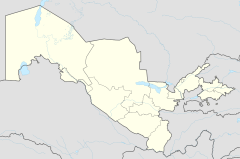| Abulkasym Madrassah | |
|---|---|
Abulqosim madrasasi | |
 2007 Uzbek stamp showcasing the Abulkasym Madrassah | |
| Religion | |
| Affiliation | Islam |
| Location | |
| Municipality | Tashkent |
| Country | Uzbekistan |
| Geographic coordinates | 41°18′24″N69°14′24″E / 41.3067°N 69.2399°E |
| Architecture | |
| Style | Renaissance |
| Creator | Abul Kasim |
The Abulkasym Madrassah is an architectural monument located in Tashkent, Tashkent Province, Uzbekistan. [1] It consists of a madrasa, a mosque and a khanaqah. The building was the location of the signing of a peace treaty in 1865 following the Russian capture of Tashkent.[ citation needed ]

